Laos 1994 "Dinosaurs of Laos"
| <prev | back to index | next> |
| Issue Date | 08.12.1994 |
| ID | Michel: 1435-1437; Scott: 1200-1202; Stanley Gibbons: 1421-1423; Yvert et Tellier: 1157-1159; Category: pR |
| Designer | Mr. Vongsavanh Damlongsouk, based on illustration of John Sibbick. |
| Stamps in set | 3 |
| Value |
50K - Theropoda 380K - Iguanodon 420K - Sauropoda |
| Size (width x height) | 30mm x 43mm |
| Layout | |
| Products | nothing |
| Paper | |
| Perforation | 13x13 |
| Print Technique | Offset lithography |
| Printed by | Vietnam, Post Printing company in Ho Chi Minh City |
| Quantity | 15.000 |
| Issuing Authority |
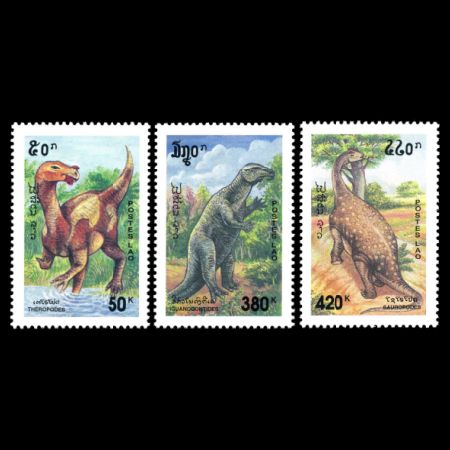
On December 8th, 1994, the Post of Laos issued their third set of stamps dedicated to Prehistoric Animals.
These colorful, but very abstract, reconstructions of these dinosaurs were chosen for this set of stamps at this time. Unlike the previous two sets, this time the stamps show dinosaurs found in Mesozoic rock units of Laos.
 |
|
Josué-Heilman HOFFET (1901-1945), discover of the first dinosaur fossils in Laos. Image credit: Wikimedia. |
During geological mapping of terrestrial formations of Bas-Laos, near the village of Tang Vay (120 km east of Savannaketh), he accidentally discovered various dinosaur fossils, as well as the remains of turtles and crocodiles.
Based on these fragmental remains that included a large femur and a small caudal vertebra, HOFFET described two new dinosaur species Titanosaurus falloti (the specimens name honors Paul Fallot, HOFFET's mentor at the University of Nancy) in 1942 and Manchurosaurus laoensis (Hadrosaur or commonly referred to as Duck-billed dinosaurs) in 1943.
In 1940, while the Japanese occupied Laos, HOFFET was mobilized and joined the intelligence services in Hue in Vietnam. He disappeared in 1945 during the fighting at the Nui Tho Pass near Hanoi, and was then declared as “dead for France” in 1947.
In 1990 paleontologist Philippe Taquet, then director of the National Museum of Natural History in Paris, took over the work of Josué-Heilman HOFFET. He organized several expeditions to the country and found several dinosaur deposits from the Lower Cretaceous, Aptian-Albian Age (126-100 million years ago), notably at Ban Tang Vay, Ban Nakhapong, and at Ban Viengh Hay. Paleontologists suggests that the fossil-bearing red beds of Laos are equivalent to the Khok Kruat Formation of the Khorat Group in Thailand.
These discoveries show a great resemblance between the dinosaurs of Laos and those of China, thus confirming the links between the Indochinese peninsula and the rest of Asia during the Cretaceous period.
Fossils of four different dinosaurs were found by the expedition:
- a Psittacosaurus, a small dinosaur with a parrot's beak
- a medium-sized Iguanodon
- a large Sauropod (a complete hind leg and 30 vertebrae of the tail of the same individual)
- a quadrupedal herbivorous dinosaur, who was named after Josué-Heilman HOFFET Tangvayosaurus hoffeti
As these dinosaurs were not yet well described in 1994, when the stamps were issued, similar dinosaurs from the same taxa were depicted on the stamps. The sauropod stamp has an illustration of Saltasaurus which is likely similar to Tangvayosaurus – a well-known Laotian dinosaur at the time the stamps were issued.
 |
|
Holotype of Tangvayosaurus, Dinosaur Museum, Savannakhet, Laos. The image is from Wikipedia, Photographer: Chaoborus. |
Tangvayosaurus (meaning "Tang Vay lizard") is a genus of sauropod dinosaur from the Aptian-Albian Age Early Cretaceous from the Grès supérieurs Formation of Savannakhet, Laos.
It was a primitive or basal herbivorous dinosaur that is classified as part of the Titanosaurs. The Titanosaurs were a group that included some of the largest dinosaurs who ever roamed the Earth. Tangvayosaurus was about 15 meters long and weighed 15 tons in life. Unfortunately, this species is only known from the fragmented remains of 2 or 3 individuals.
As it is described from singles bones only, the exact placement of Tangvayosaurus is debated. The most recent classification tentatively retains this genus, because it is sufficiently different from a sauropod from next door in Thailand, Phuwiangosaurus. Phuwiangosaurus was depicted on a 1997 stamp from Thailand.
Iguanodon-like dinosaur
A few bones of an Iguanodon-like dinosaur have also been discovered in Laos prior to this issue being published. Even today, these bones are still too incomplete and fragmented to assign this dinosaur to a specific species.
Iguanodon, right after it was described in 1825, was portrayed as a quadrupedal horn-nosed beast.
Since 1882, after the largest find of Iguanodon remains in a coal mine at Bernissart in Belgium, Iguanodon was portrayed as a bipedal dinosaur standing by a tree and eating.
During his re-examination of Iguanodon, in 1980, Dr. David Norman, who also wrote "The Illustrated Encyclopedia of Dinosaurs" book, that inspired the stamp designer, was able to show that this posture was unlikely, because the long tail was stiffened with ossified tendons. Since then, it is accepted to portrayed Iguanodon as quadrupedal dinosaur. However, long after 1980 Iguanodon was still depicted in many books and postage stamps, in old style, staying or walking on two legs.
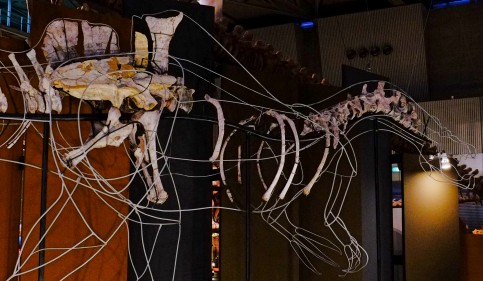 |
| Fossils of Ichthyovenator. Image credit: Wikimedia, Photographer: ★Kumiko★. |
Ichthyovenator (meaning "Fish Hunter") is a genus of spinosaurid dinosaur from the Aptian-Albian Age Early Cretaceous (125 and 113 million years ago), from Gres superieurs Formation of Savannakhet, Laos.
This specimen became the holotype of the new genus and species Ichthyovenator laosensis, and was described by palaeontologist Ronan Allain and colleagues in 2012. The species’ name refers to the provenance from Laos.
The estimated size of the dinosaur is 8.5 - 10.5 meters long and weighing 2.5 tons. Like other dinosaurs of the Spinosaurid family, Ichthyovenator had tall neural spines that formed a sail on its back. The unique feature of Ichthyovenator is sinusoidal (wave-like) sail shape that curved downwards and divided into two separate sails.
Original illustrations
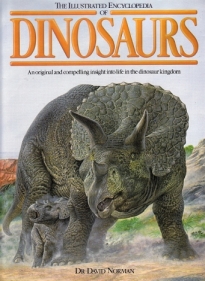 |
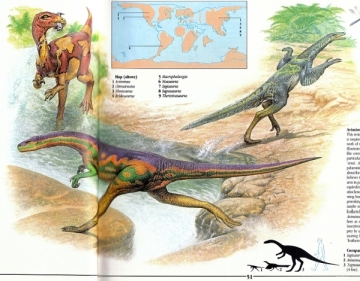 |
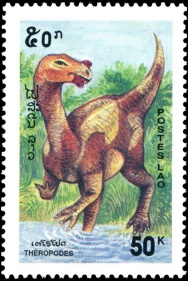
|
|
Segnosaurus in an illustration drawn by John Sibbick. The image is from chasmosaurs.blogspot.com |
Theropoda dinosaur on stamp of Laos, MiNr.: 1435 Scott: 1200 | |
|
"The Illustrated Encyclopedia of Dinosaurs" by David Norman, issued in 1988.
ISBN: 0517468905 The book provides detailed examination of the world of dinosaurs, their appearance, behavior, and families, describing some theories about their extinction and explaining how paleontologists study their fossilized remains, as it was at the time of the book publication. |
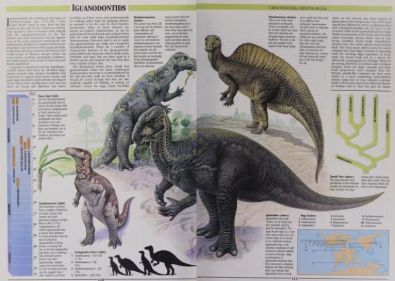 |
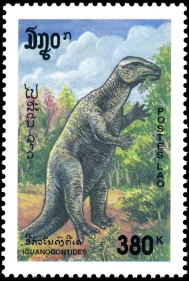
|
|
Muttaburrasaurus on an illustration drawn by John Sibbick. The image is from Dinopedia |
Iguanodon-like dinosaur on stamp of Laos, MiNr.: 1436 Scott: 1201 |
|
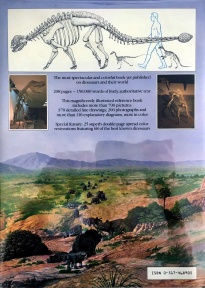 |
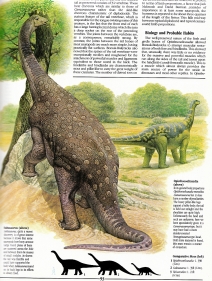 |
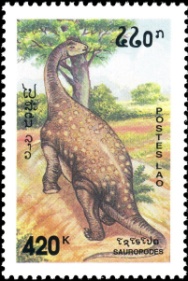
|
|
Saltasaurus in an illustration drawn by John Sibbick. The image is from chasmosaurs.blogspot.com |
Sauropod dinosaur on stamp of Laos, MiNr.: 1437 Scott: 1202 |
Products
References
- The stamp issue: stampedout.nl, original-briefmarken.de.
- Joshua-Heilmann HOFFET: Wikipedia (in French), dinosauria.org (in French), aictpl2.pagesperso-orange.fr (in French).
- Dinosaurs discoveries in Laos:
Fossil Wiki,
Savannakhet Dinosaur Museum,
"Dinosaur Investigation of Lao PDR", by Phornphen Chanthasit, written for the 2nd Lao-Thai Technical Conference on Geology and Mineral Resources, January 17-18, 2013.
- Tangvayosaurus: Wikipedia, Fossil Wiki, Prehistoric Wildlife, Dinodata (in German) .
- Ichthyovenator: Wikipedia, Fossil Wiki, Prehistoric Wildlife.
- Iguanodon: Wikipedia, Encyclopædia Britannica,
- John Sibbick: About, Gallery, "Vintage Dinosaur Art: The Illustrated Encyclopedia of Dinosaurs", on Love in the Time of Chasmosaurs blog.

|
Acknowledgements
- Many thanks to Dr. Peter Voice from Department of Geological and Environmental Sciences, Western Michigan University, for his draft page review and his valuable comments.
- Many thanks to fellow collector Ton van Eijden, who run another website about prehistoric life on stamps: stampedout.nl, for his help to find an information about original illustrations.